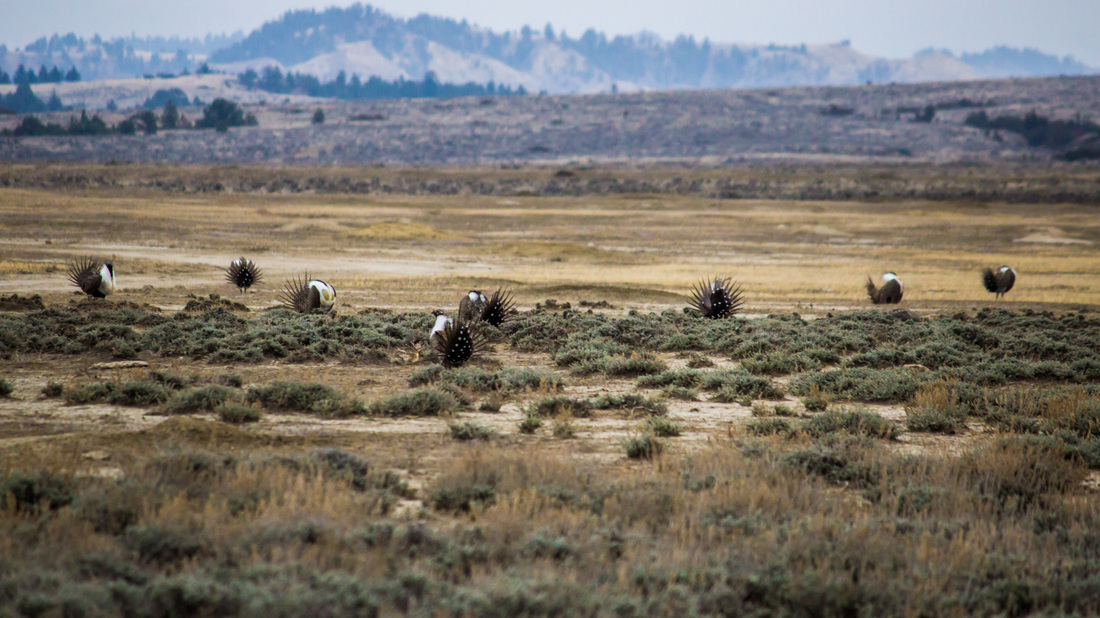By: Laine McCall
Landmark Adventure Scientist
Landmark Adventure Scientist
Spring on the American Prairie Reserve means lekking season for the region’s two species of grouse. “Lekking” refers to a mating strategy used by some species where males display in a communal space, called a lek, to impress females. Meriwether Lewis provided the first written description of greater sage-grouse in what is now Montana on the famous 1805 journey across the newly obtained Louisiana territory. Sage grouse are of particular concern because they are near being labeled ‘threatened’ by the IUCN. Sage grouse population numbers have dropped from historical estimates of 16 million to around 200,000 individuals.[1]
Sage grouse lekking grounds are described as bare areas where males compete to mate with females using elaborate displays. The competition is high stakes because the most dominant male in any given lek usually mates with around 80% of the group’s females, leaving the majority of male grouse without a mate for the breeding season.
A male sage grouse displaying on a lek at the American Prairie Reserve. Video by Elaine Kennedy.
Grouse are considered by some to be “America’s Bird of Paradise” because the intense competition on the lekking grounds has led to the evolution of some unusual and seemingly disadvantageous displays. Male sage grouse will puff out their feathers and make unusual calls. It requires roughly a gallon of air for a male sage grouse to make their lekking calls. Although it may seem counterproductive to survival to have elaborate and energetically expensive displays, it is necessary for males to display for several hours every morning through the entire breeding season for a chance to pass on their genetic material.
Landmark crews go out to monitor the sage grouse leks from late March-early May. Using a GPS to help us locate previously marked lek grounds, we arrive at the site half an hour before sunrise. Once it becomes light enough for us to clearly see the birds, we use spotting scopes and binoculars to count them. Each person takes three total counts of the males and females on the lekking ground. Using iPads, we then record the highest counts along with weather and habitat data. Typically we have more than one lek to visit each morning, so we have to move quickly to the next lek because the birds are most active from 15 minutes before sunrise to 45 minutes after sunrise.
Landmark crews go out to monitor the sage grouse leks from late March-early May. Using a GPS to help us locate previously marked lek grounds, we arrive at the site half an hour before sunrise. Once it becomes light enough for us to clearly see the birds, we use spotting scopes and binoculars to count them. Each person takes three total counts of the males and females on the lekking ground. Using iPads, we then record the highest counts along with weather and habitat data. Typically we have more than one lek to visit each morning, so we have to move quickly to the next lek because the birds are most active from 15 minutes before sunrise to 45 minutes after sunrise.
In September of 2015, the U.S. Fish and Wildlife Service decided not to add greater sage-grouse to the Endangered Species list despite massive population decline, which reinforces the importance of monitoring these populations. Like many grassland birds, one factor in the decline of sage grouse is the loss and fragmentation of viable habitat (sagebrush is a critical part of sage grouse diets).[2] Sagebrush habitat has been greatly reduced and now exists in only 56 percent of its historic range.[3] Restoration of sage grouse habitat benefits other grassland birds and native prairie species. Observing sage grouse populations is important in studying sagebrush ecosystems because sage grouse are an indicator species, meaning that the status of sage grouse populations is a good reflection of the overall health of the entire sagebrush ecosystem.[4]
1 https://www.allaboutbirds.org/guide/Greater_Sage-Grouse/lifehistory
2 https://www.allaboutbirds.org/guide/Greater_Sage-Grouse/lifehistory
3 https://www.fs.usda.gov/Internet/FSE_DOCUMENTS/stelprd3839884.pdf
4 https://www.fs.usda.gov/Internet/FSE_DOCUMENTS/stelprd3839884.pdf
2 https://www.allaboutbirds.org/guide/Greater_Sage-Grouse/lifehistory
3 https://www.fs.usda.gov/Internet/FSE_DOCUMENTS/stelprd3839884.pdf
4 https://www.fs.usda.gov/Internet/FSE_DOCUMENTS/stelprd3839884.pdf
Learn more about Landmark and other ASC projects on our website, the Field Notes blog, and by following us on Facebook, Twitter, and Instagram.


